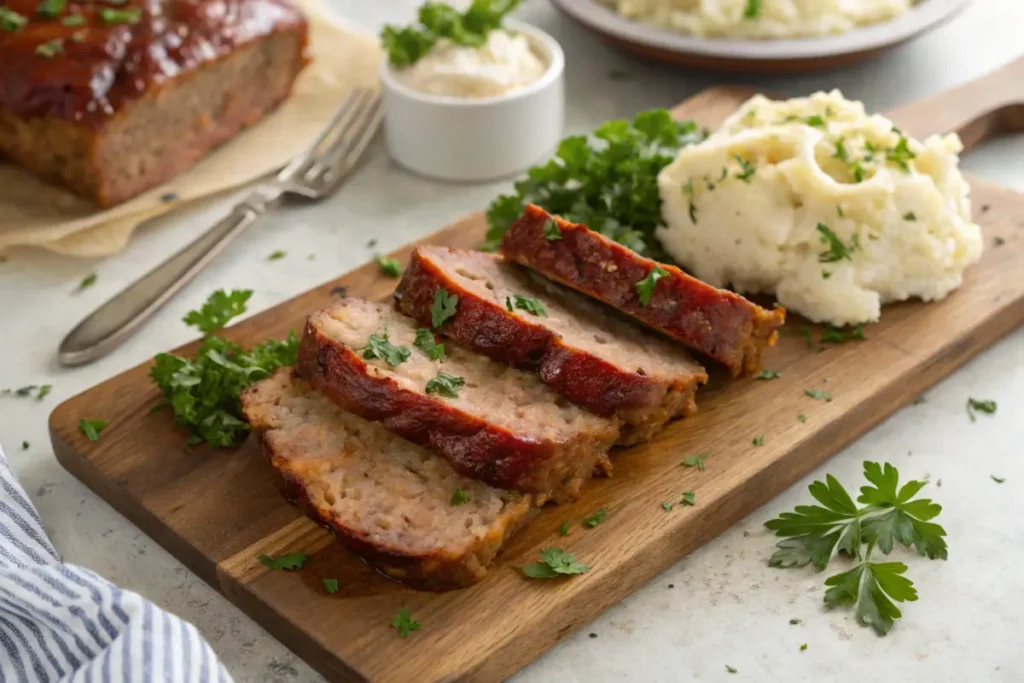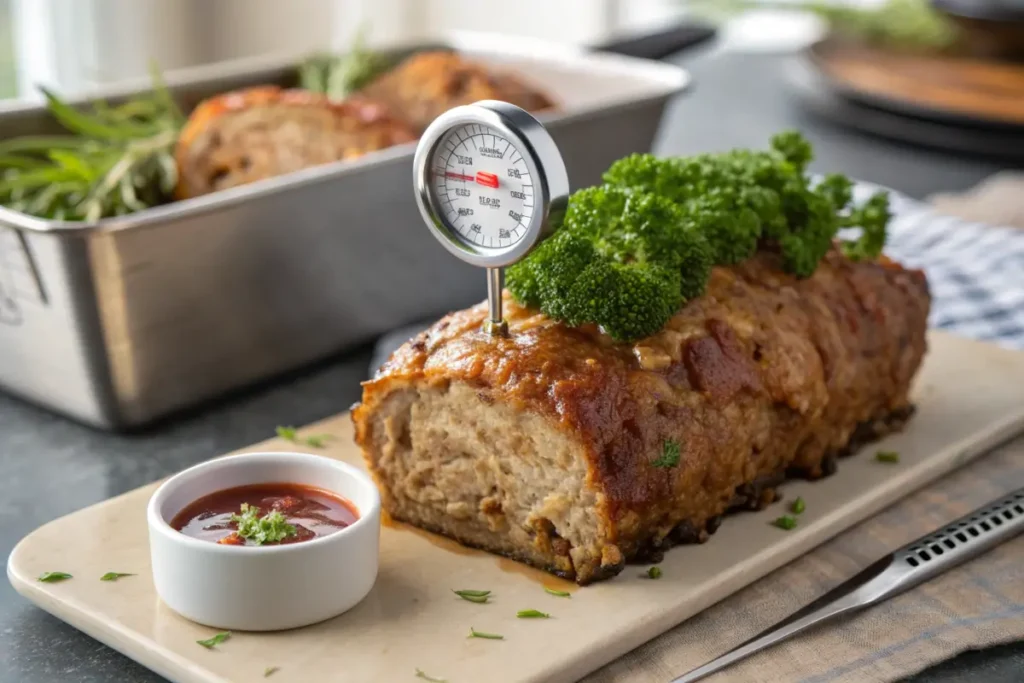Meatloaf has long been a beloved dinner staple in countless households around the world. But what is the secret to juicy meatloaf? Is it all about the best meatloaf ingredients, cooking method, or even the right combination of binders? In this article, we’ll shine a light on everything from the humble dish’s historic beginnings to the latest cooking tips that help you achieve a moist meatloaf recipe every time.
We’ll walk through Old-World traditions, explore how this hearty entrée found its way into American culture, and—most importantly—share proven secrets for ensuring each slice remains tender and delicious.
The History and Origins of Meatloaf
From Old-World Traditions to American Moist Meatloaf
Many people assume that classic American meatloaf is a purely modern concept, yet its roots stretch back centuries to Old-World Europe. In medieval times, ground meat was often combined with oats, bread crumbs, or rice in order to stretch scarce resources. Meanwhile, cooks tested various seasonings to enhance flavor.
Because these early settlers arrived on new shores with a range of cultural practices, they brought along their traditional meat-blending methods. Over time, this spared-no-detail approach to meatloaf naturally evolved, particularly as it transitioned from frugal necessity to a comforting family favorite.
Moreover, different regions refined their recipes in ways that mirrored local tastes, using herbs unique to each cultural heritage.
How Juicy Meatloaf Evolved Over Time
While it began as a simple peasant dish, this savory loaf gradually turned into a symbol of home-cooked dinners in North America. By the early 1900s, resourceful households were repurposing scraps of beef, veal, or pork to craft a tender meatloaf. Recipes soon found their way into cookbooks, demonstrating how to optimize flavor by balancing spice profiles and fine-tuning cooking methods.
Over subsequent decades, new innovations—like the use of specific meatloaf binding agents—helped lock in moisture. These shifts in ingredients and techniques not only offered variety but also kept pace with economic and dietary changes across the nation. As a result, meatloaf quickly earned its reputation as a down-home meal, embodying the spirit of comfort food for generations to come.
What Is the Secret to Juicy Meatloaf? Must-Have Ingredients
The Key Role of Eggs and Dairy in Moist Meatloaf
Eggs provide binding power in a moist meatloaf recipe. However, they do more than simply hold everything together. Because they contain proteins that coagulate in heat, eggs help create a tender, springy texture. In addition, including a small amount of milk or cream goes a long way toward maintaining moisture.
Furthermore, dairy contributes subtle richness that can turn your loaf into a family-friendly dinner idea. Many no-fail meatloaf methods also call for a splash of sour cream or yogurt, since these tangy elements make each bite smoother. Consequently, selecting high-quality dairy and eggs ensures you’re starting out with some of the best meatloaf ingredients that keep your dinner from drying out.
Choosing Quality Ground Meat for a Succulent Meatloaf
Naturally, it all begins with fresh ground meat. Yet, what is the secret to juicy meatloaf? Picking cuts that boast the right balance of lean and fat content is key. Moreover, blending ground beef with other meats—like veal or pork—often adds complexity. Although some folks stick to leaner options, a moderate amount of marbling ushers in flavor and locks in juiciness.
Meanwhile, butchers or grocery stores typically offer prime ground selections, making it easier to craft a simple homemade meatloaf without sacrificing taste. Also, watch for any discoloration, freezer burn, or off-smelling product. By seeking out quality ground meat, you set the stage for a loaf that bakes beautifully, stands tall on your dinner plate, and delivers that classic American meatloaf goodness in every forkful.
Selecting the Right Meat and Fat Ratio
Blending Different Meats for Enhanced Meatloaf Flavor
Often, people wonder how to upgrade their tender meatloaf tips. One approach involves mixing more than one type of ground meat. For example, blending beef with pork can yield a delightful richness, thanks to the pork’s slightly higher fat content. Additionally, some cooks experiment with ground veal for an even silkier texture.
Because each variety brings its own characteristics, it pays to experiment with your ground beef ratio until you discover your personal sweet spot. Furthermore, tossing in fresh herbs in meatloaf—like thyme or parsley—intensifies flavor without overwhelming the natural taste of the meats. Between the different cuts and added seasonings, a multi-meat approach often yields that truly juicy meatloaf everyone craves.
Why the Fat Content Matters for a Moist Meatloaf
Yet, blending meats alone won’t answer what is the secret to juicy meatloaf? Fat percentage also plays a pivotal role. If it’s too low, your loaf might emerge stiff or crumbly. On the other hand, using extremely fatty cuts can result in an overly greasy finish. Consequently, striking the perfect balance, around 80% lean to 20% fat, typically delivers the richest, most satisfying bite.
In addition, higher fat content means increased moisture transfer during baking. As a result, your loaf remains succulent as it bakes, locking in savory juices. Ultimately, balancing meat types and fats not only guarantees a simple homemade meatloaf, but also ensures that every slice looks and tastes like a true labor of love.
Binding Agents and Fillers for Moisture Retention

Breadcrumbs, Oats, and Other Options
Binding agents play a huge role in creating a moist meatloaf recipe, especially when you’re seeking family-friendly dinner ideas. Although classic breadcrumbs are popular, there are countless other options for maintaining the right texture. For instance, oats offer a slightly chewier, heartier finish.
Meanwhile, ground crackers, panko, or even crushed cereal can contribute both taste and structure. Moreover, these meatloaf binding agents help absorb extra liquid and keep everything cohesive. Because each option varies in flavor, it’s wise to try out different fillers.
In doing so, you may discover a new favorite among these no-fail meatloaf methods. Furthermore, choosing a filler that aligns with your personal dietary needs can open up more possibilities—gluten-free bread or almond flour, for example.
How Starches Help Keep Meatloaf Juicy
Starches such as potatoes or cooked rice can also enhance tenderness. Because they act like sponges, they soak up the savory juices that would otherwise escape during baking. Consequently, each slice maintains greater moisture, preventing crumbly textures.
Additionally, these starches can make recipes more comfort food favorites while keeping an eye on how to keep meatloaf moist. Plus, using mashed potatoes or cooked rice adds another subtle layer of flavor to your loaf. Therefore, it pays to experiment with these unique binders for an even juicier result.
Overall, combining the right filler with essential seasonings ensures your simple homemade meatloaf remains delicious and satisfying, proving that great texture starts with the correct balance of meat, binders, and technique.
What Is the Secret to Juicy Meatloaf? Flavorful Add-Ins: Herbs, Spices, and Vegetables
Elevating Taste with Fresh Herbs and Seasonings
Seasonings can transform average meatloaf into a memorable dish. By sprinkling dried oregano, basil, or thyme, you add subtle aromatics that enhance every bite. Furthermore, spices for savory meatloaf, like paprika or garlic powder, lend layers of depth. Yet, fresh herbs often outshine their dried counterparts.
Because they’re packed with natural oils, fresh herbs in meatloaf release vibrant flavors once exposed to cooking heat. Therefore, do not shy away from experimenting with combinations that tantalize your palate. Additionally, salt and pepper remain fundamental, so carefully adjust amounts to suit your personal taste.
Adding Onions, Peppers, and More for Extra Moisture
Incorporating chopped onions, bell peppers, or mushrooms makes your loaf both flavorful and juicy. Indeed, veggies contribute natural moisture that helps ward off dryness. Plus, their mellow sweetness pairs beautifully with beef, pork, or turkey. Meanwhile, some cooks like to sauté these vegetables first to intensify their essence.
As a result, they blend easily with the meat mixture and lock in more juices. Whether you choose to add finely diced carrots, zucchini, or peppers, remember that every vegetable addition can boost texture. Lastly, top off the loaf with a tangy sauce, and you’ll capture the perfect bite—proving yet again what is the secret to juicy meatloaf? It’s all about careful ingredient choice and smart preparation methods.
To complement your juicy meatloaf, consider adding a side dish like our Chicken Francese Maggiano’s recipe for a complete Italian-inspired meal.
What Is the Secret to Juicy Meatloaf? Cooking Time and Temperature

Finding the Ideal Internal Temperature
Timing and temperature often make or break a tender meatloaf. Although details vary, most cooks recommend baking at around 350°F (175°C) until the internal temperature reaches 160°F (71°C). Because ovens differ, it’s wise to invest in a meat thermometer. Once your loaf hits that ideal level, further cooking can dry it out.
Meanwhile, checking the temperature early and often helps you avoid overbaking. In fact, some folks pull the loaf out at 155°F, then let carryover heat do the rest. Consequently, the final texture stays moist, echoing the point that what is the secret to juicy meatloaf? It involves precision in both time and heat.
Foil, Pans, and Other Cooking Methods
Furthermore, your choice of pan or baking style can influence moisture. Traditional loaf pans work well, though shaping your meat free-form on a baking sheet gives the edges a slightly crisp bite. Because some families prefer to retain more juice, covering your loaf with foil during the early part of baking can seal in steam.
Afterward, removing the foil for the last 15 minutes allows the glaze to caramelize. Additionally, some daring home cooks even opt to smoke or grill their meatloaf for a bold twist. Whichever method you try, remember to monitor it closely. Ultimately, using proper tools and keeping a watchful eye on temperature ensures that each bite remains succulent, flavorful, and worthy of its iconic status.
FAQs
How Do I Keep My Meatloaf from Falling Apart?
Usually, the right ratio of binder to meat helps stabilize the loaf. Moreover, eggs, breadcrumbs, or oats serve as essential meatloaf binding agents. Adding enough moisture-producing ingredients like onions or bell peppers also helps hold everything together.
Should I Cover My Meatloaf While It Bakes?
Yes, but only partially through the cooking process. Initially covering it locks in steam and helps prevent dryness. Afterward, remove the cover to let the top brown and firm up.
What Can I Use Instead of Breadcrumbs?
When you’re looking for simple homemade meatloaf alternatives, oats, crushed crackers, panko, or even almond flour are popular options. Because these binders act similarly, pick one that meets your taste and dietary needs.
Can I Use Turkey Instead of Ground Beef for Meatloaf?
Absolutely. Turkey is a family-friendly dinner idea that is leaner. However, because turkey contains less fat, consider adding extra moisture. Include an additional egg or increase the amount of milk and veggies to enhance juiciness.
What Sauce or Glaze Is Best for Meatloaf?
Ketchup, barbecue sauce, or a mixture of ketchup and brown sugar remain classic choices. Yet, you can explore tangy tomato-based sauces, mushroom gravies, or even pesto for a flavorful spin. After all, what is the secret to juicy meatloaf? It’s all about adding just the right finishing touch to seal in that savory goodness.
Looking to diversify your dinner options? Try our Chicken Marsala Maggiano’s recipe for a flavorful alternative.
Conclusion: Bringing It All Together
Final Thoughts on Crafting the Perfect Meatloaf
By now, you’ve explored every aspect of this popular comfort food favorite, from the best cut of meat to the importance of binders. Indeed, what is the secret to juicy meatloaf? It boils down to a few core elements: the right balance of fat, well-chosen fillers, a flavorful blend of herbs, and careful cooking techniques.
Moreover, being mindful of your oven temperature and using a trusty meat thermometer can make all the difference. Therefore, it’s worth paying attention to each step, because missing any one detail may result in a loaf that’s either too dry or lacks flavor.
Encouragement to Experiment with Variations
Finally, keep in mind that there’s no single, one-size-fits-all recipe. In fact, some of the most family-friendly dinner ideas come from mixing different meats or trying new spice blends.
By experimenting with fresh vegetables, alternative fillers, or unexpected sauces, you’ll discover your own no-fail meatloaf methods. Ultimately, learning how to adapt the fundamentals allows you to find that sweet spot—where your loaf is always deliciously juicy and entirely unique to your table.
In addition to the essential binders, incorporating recipes like our Chicken Piccata Maggiano’s recipe can inspire you to enhance your meatloaf with complementary dishes.
- Chicken Francese Maggiano’s Recipe:
Add an Italian flair to your meals with our delicious Chicken Francese Maggiano’s recipe. - Chicken Marsala Maggiano’s Recipe:
Elevate your dinner with our savory Chicken Marsala Maggiano’s recipe. - Chicken Piccata Maggiano’s Recipe:
Enjoy a tangy and flavorful dish by trying our Chicken Piccata Maggiano’s recipe. - Maggiano’s Chicken Piccata:
Recreate the mouthwatering Maggiano’s Chicken Piccata at home with our easy-to-follow guide. - Maggiano’s Recipes Italian Classics:
Discover more Italian favorites in our Maggiano’s Recipes Italian Classics collection. - Feta Vegetable Bake Recipe:
Pair your juicy meatloaf with our tasty Feta Vegetable Bake recipe for a complete meal.






